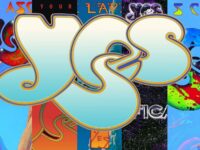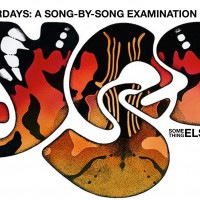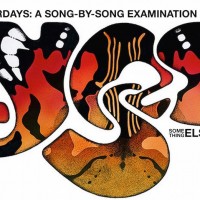Nestling unobtrusively in every great artistic oeuvre is at least one hidden gem. My personal collection would include, amongst many others, Aaron Copland’s Nonet for Strings, Leonard Bernstein’s Prelude Fugue and Riffs, Deep Purple’s Concerto for Group and Orchestra, and Mike Oldfield’s Taurus 3.
For me, the studio songs on 1996’s Keys to Ascension and 1997’s Keys to Ascension 2 contain more than one of these gems and it’s an on-going irritation to those of us who know and love this music that they remain obscure. If you can find a copy of the compilation Keystudios, then you’ll get an idea of how a proper Yes album could have sounded, rather than the new songs being hidden away on second discs of the two Keys albums while live recordings took center stage. This is what Rick Wakeman wanted all along, he has said.
“Mind Drive” from Keys to Ascension 2 has its origins (at least in part) in the short-lived and frustratingly unproductive XYZ project, which Chris Squire, Alan White and Jimmy Page attempted to get off the ground around 1980-81, and brings us back full circle to the ’70s line up of Jon Anderson, Alan White, Squire, Wakeman and Steve Howe. The full track is a world away from the XYZ version and, at more than 18-and-a-half minutes long, this was a deliberate attempt to recapture the epic structure and feel of Yes’ so-called main-sequence albums. For me, it works brilliantly.
From the opening Howe acoustic guitar moments, where he employs classical techniques by sequencing small figures, it’s pure, classic Yes. Wakeman bathes the scene in characteristic, slow washes of keyboards and Squire joins in with a complementary line which perfectly matches Howe’s opening in mood and feel. After this introduction, the original XYZ material appears, enhanced this time both by the instrumentalists involved and, of course, by proper production shared between the band themselves and none other than multi-instrumentalist, multi-role Yes stalwart, Billy Sherwood.
A new rhythmical motif is introduced on bass and snare drum which turns into an ostinato pattern rather reminiscent of the approach taken in Ravel’s Bolero. There’s a feeling of approaching menace here, a bit like some sections of Drama. Wakeman’s chordal additions are very orchestral in style and there are pitched percussion instruments in the mix – but not used as they were on 90125 – this time they are more integrated into the mix.
Interestingly, despite being more nearly 20-minutes long, there are no specified sections in the track. However, one of the most important indicators of progressive music is that it is given space and time to develop to its full potential – and that’s exactly what Yes has done here. Howe embarks on the scale of soloing not seen since Tales from Topographic Oceans and the vocal passages are new material with Jon Anderson providing some of his most strident singing ever. The title proves to be extremely apt, as the music blows your mind with its unstoppable motion and drive.
The declamation of “Ascend and Create – Ascension” is one of the best, spine-tingling moments in the whole Yes canon. It’s a brilliant notion to include the album title in this way – or maybe it was the other way round? Could any band other than Yes have created this masterwork? The answer (contrary to my usual assertion) is certainly, “No.”
That rhythmical pattern is repeated at high volume and pitch and then the keyboards calm the mood right down via spacey sound effects to bring us to a completely new section where verses of quieter resolution are interspersed with louder melodic choruses, reminding us of the traditional Yes technique of direct contrast. The treatment and orchestration of the quieter passages are fascinating: Listen closely for some great Chris Squire bass lines, which contribute to the idea that the band telling the story of how mankind can gain the Keys to Ascension. This is surely what Yes fans had been waiting for – a real splash of that longed-for awe and wonder in the classic albums, a sense that Yes music transcends fad, fashion and trend and exists in a place far beyond the ordinary.
A passage of Howe acoustic work appears, supported by the rest of the musicians in an oasis of peace in the middle of the track. Jon Anderson’s light, reverb-soaked line floats above in a sequence of true beauty. Then some fast hi-hat work from Alan White ushers in the next section and Rick Wakeman undertakes a full-blooded prog-tastic solo. Next, what do we have? Almost bringing tears to the eyes: It’s Howe replying to Wakeman’s solo with one of his own – a real sparring match and it’s as if we are back in the mid-’70s – albeit with better sound quality and slightly more palatable wardrobe choices.
More changes are moved through in a dazzling construction of complexity and stability before Wakeman embarks on a huge solo with a remarkable synth voice and some of the fastest, most intricate playing for years. Big chords from the whole band arrive and the track is redoubled again with a wall of sound complete with another Rock Wakeman solo.
Finally, however, it all diminishes and we are left with an odd little epilogue, very quietly in the background of the sound reminiscent of fairground music. Perhaps it’s the ghost of “The Circus of Heaven,” finally being chased out of town.
The re-assembling of the classic Yes line up seems also to have re-kindled the creative spirit and power they had in the 1970s. The overall impression I get from “Mind Drive” is one of mastery: From the lyrics to the way it’s all dovetailed together, it’s a tour de force of progressive rock. For me, “Mind Drive” is an epic which is the equal of many from previous decades.
- Yes, “Mystery Tour” from ‘The Quest’ (2021): YESterdays - November 23, 2021
- Yes, “Minus the Man” from ‘The Quest’ (2021): YESterdays - October 5, 2021
- Yes, “Subway Walls” from ‘Heaven and Earth’ (2014): YESterdays - December 8, 2020




